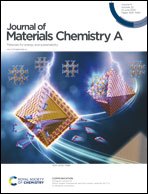A “boxes in fibers” strategy to construct a necklace-like conductive network for high-rate and high-loading lithium–sulfur batteries†
Abstract
The practical application of lithium–sulfur batteries has been restricted by the low operating rates and the low areal sulfur loading, resulting from the insulating and dissolving nature of sulfur and lithium polysulfides. Herein, we propose a “boxes in fibers” strategy and build a hierarchical three-dimensional conductive network, which is based on necklace-like N-doped carbon nanofibers with threaded hollow carbon nanoboxes and TiC nanoparticles (CNB–TiC@CNF), via a facile electrospinning process. Ideally, a large amount of sulfur could be loaded in the hollow cavities of CNBs and the pores of CNFs, with physically/chemically active sites, while the interconnected conductive network is beneficial for fast Li+ diffusion and electron transfer. Depending on the hierarchical and porous framework, the volume variation of the lithium polysulfides can be further alleviated. The as-constructed CNB–TiC@CNF with enhanced adsorption and conversion ability to polysulfides achieves a high discharge capacity of 1611 mA h g−1 at 0.1C, high-rate performance up to 10C for 400 cycles with a decay rate of 0.15% and high sulfur areal loading performance with a stable areal capacity of 7.90 mA h cm−2 at 9.2 mg cm−2. Our work provides a novel and efficient strategy for the construction of a three-dimensional hierarchical host as a high-performance cathode for lithium–sulfur batteries.



 Please wait while we load your content...
Please wait while we load your content...